It’s so frustrating when your seedlings start having problems, and you don’t know why or how to solve them. In fact, one of the questions I get asked the most by new gardeners is “What’s wrong with my seedlings?“
If this sounds familiar, and you need help, then you’ve come to the right place. The good news is that many of these issues are easily fixable with a few minor adjustments.
In this post, I’ll help you troubleshoot your seedling problems to find the cause, and give you detailed fixes and solutions, so you can finally stop struggling.
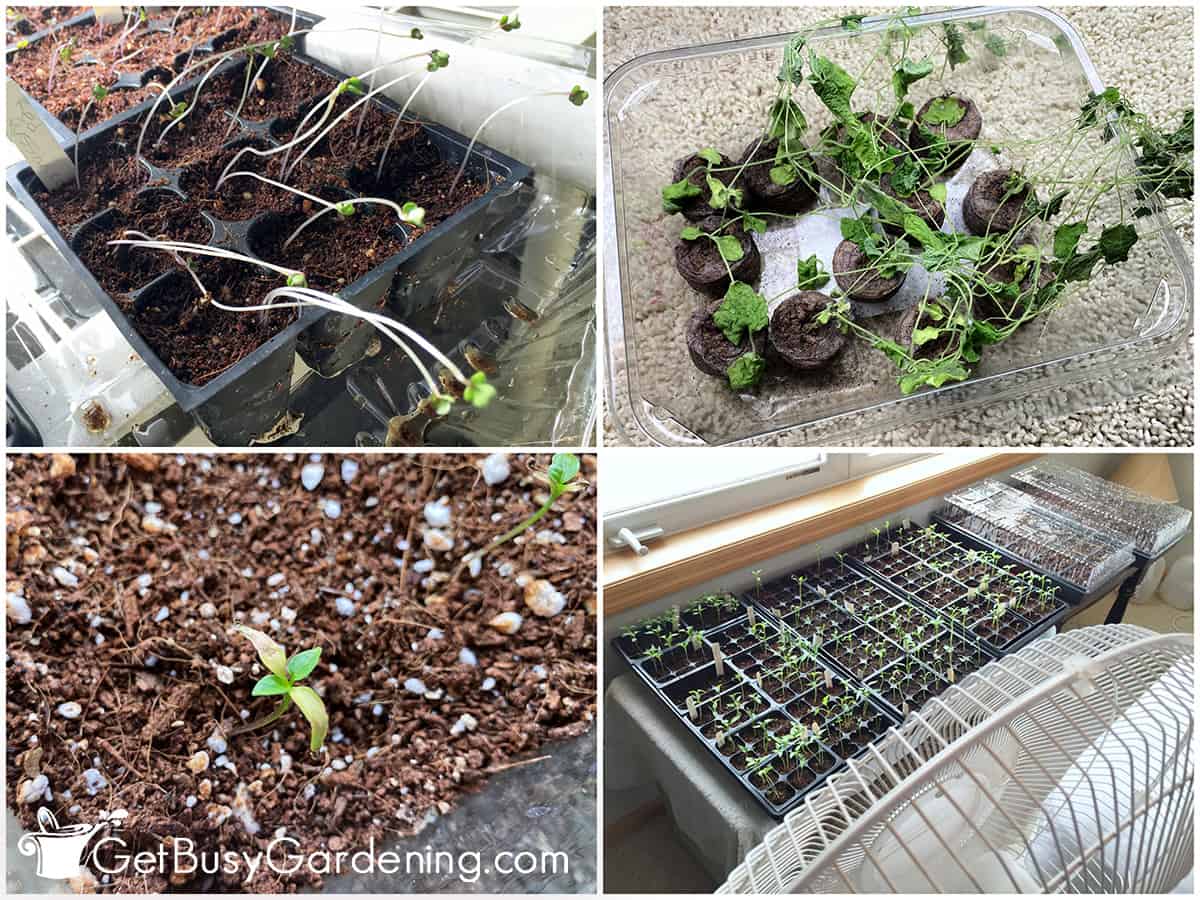
7 Seedling Problems & How You Can Fix Them
Below I will walk you through the most common seedling problems, identify the main causes, and give you the solutions for exactly how to fix them.
1. Seedlings Falling Over & Dying
When seedlings tip over at the base and die without warning, this is called damping off, and it’s caused by bacterial blight. Damping off is the most common cause of seedlings dying after sprouting.
| Causes | Solutions |
| Wrong soil: | Always use a fresh and sterile quality medium or pellets. Don’t use general potting or garden soil. |
| Dirty equipment: | Be sure to clean and disinfect your seeding trays and inserts before starting. |
| Improper ventilation: | Remove the plastic dome lids once the seeds have germinated, and run an oscillating fan over the seedlings. |
| Overwatering: | Don’t water your seedlings if the medium is already wet or soggy. Use a moisture gauge so you know when it’s time. |
| Watering from the top: | It’s best to water your seedlings from the bottom by filling the tray, rather than pouring it over the top. Dump any water that hasn’t been soaked up after 30 minutes. |
2. Seedlings Turning Yellow, Brown, Or Have Faded Leaves
When seedling leaves turn brown, yellow, white, or look dull and faded, that’s a sure sign there’s a problem. Many times you can save them, but if the damage is severe, they may not recover.
| Cause | Solution |
| Fertilizer burn: | Synthetic fertilizers are notorious for burning delicate seedlings. Switch to a natural, organic brand instead, and start by feeding with a half strength dose. |
| Wrong soil: | Heavy soils hold too much moisture, and cheap ones can stunt root development or don’t have the right nutrients. Always use a good quality mix. |
| Sunburn: | Move them out of the sun immediately, and follow these steps to harden your seedlings properly when moving them outside. Indoors, be sure they aren’t touching the grow light bulbs. |
| Overwatering: | Make sure the medium is never saturated or soggy, and drain excess water from the tray. A moisture gauge is a great tool to help you get it right. |
| Rot: | If the leaves are stuck to the inside of plastic lid for too long, it can cause them to rot. Remove the lid once the seedlings are tall enough to reach it. |
| True leaves dying: | If only the first two leaves are turning yellow, faded, or brown, that is normal and nothing to worry about. |
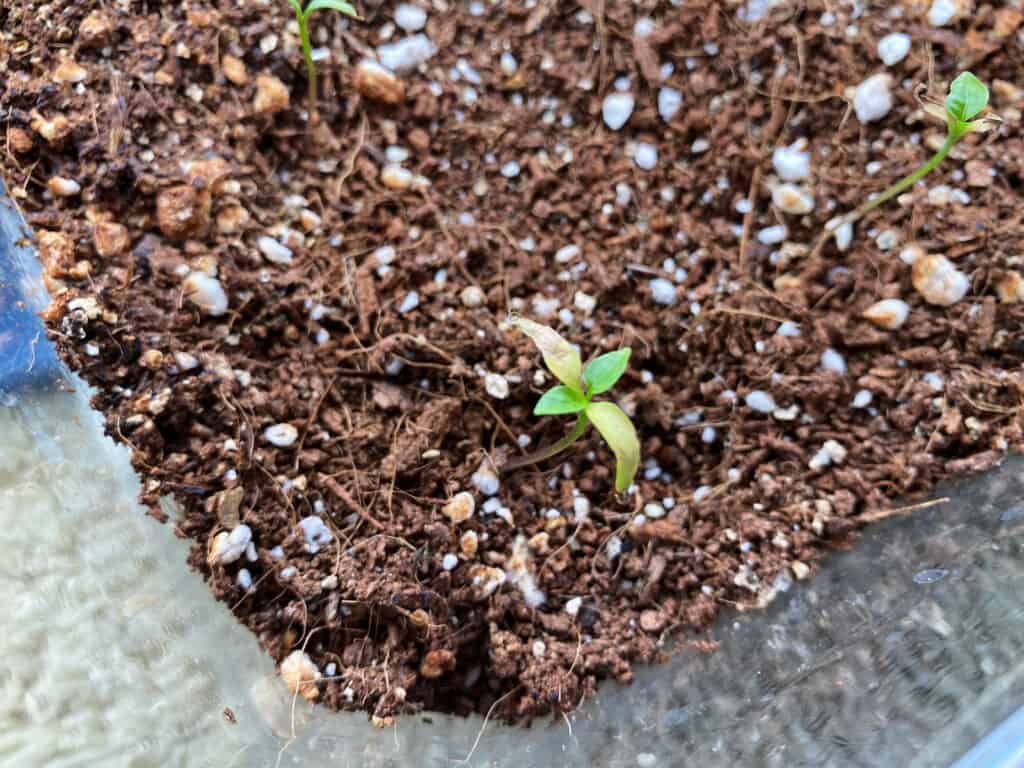
3. Weak, Leggy Seedlings
If seedlings don’t get enough light, they will reach and stretch for the brightest light source that’s nearby (usually a window).
If yours have grown so tall and leggy that they’re falling over, then it’s probably too late to save them. But you can easily prevent this problem from happening again.
| Cause | Solution |
| Not enough light: | Position a grow light so it hangs 2-4 inches above the seedlings at all times, and keep it on for 12-14 hours per day using an outlet timer. |
| Overcrowding: | Thin your seedlings by cutting out the weakest ones at the base so there’s only one left per cell, or pot them up into larger containers. |
Related Post: How & When To Use Grow Lights For Seedlings
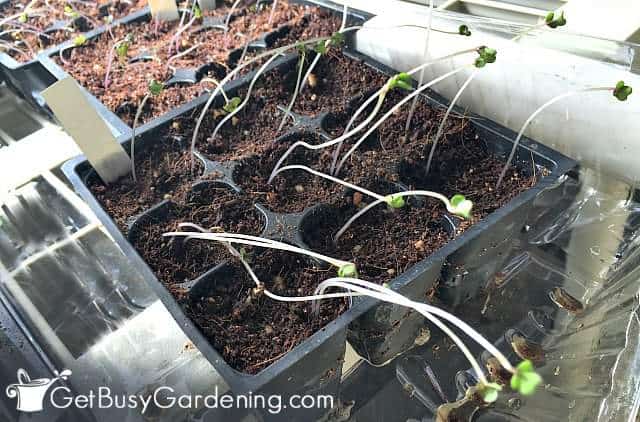
4. Mold Growth In Seed Trays
It’s not the mold that will kill your seedlings… it’s the problem(s) causing it that you have to worry about.
And if you don’t fix those issues quickly, your seedlings probably won’t survive for long. Learn more about how to get rid of mold on seedlings here.
| Cause | Solution |
| Improper air circulation: | Add an oscillating fan and position it to blow over your seedlings to give them plenty of airflow, and help to dry out soggy soil. |
| Overcrowding: | Repot your seedlings if they have outgrown their tray. Otherwise thin them to only one per cell. |
| Overwatering: | Try to allow the very top layer of soil to dry, and water from the bottom rather than over the top. Use a moisture meter to get it right. |
5. Tiny Bugs Flying Around Seedlings
Fungus gnats (aka soil gnats) are small bugs that lay their eggs in soil, and you’ll see them flying around the seedlings, or crawling in the trays.
Seeing a few flying around isn’t a big deal, they’re normally just a nuisance. But they are a sign of a bigger problem.
| Cause | Solution |
| Overwatering: | Water your trays from the bottom, pot up larger seedlings, hang sticky traps nearby to capture the bugs, and store all unused soil in an air-tight container. |
6. Seedlings Not Growing, Or Growing Slowly
Sometimes seedlings can grow very, very slowly, or they seem to stop all together. It’s perfectly normal for some to be slower than others. However, there are a few problems that can slow or stunt their growth.
| Cause | Solution |
| Cold temperatures: | If the temperature is below 65°F, then try keeping your seedlings warm using a space heater or a heat mat. |
| Not enough light: | It’s best to always keep them under grow lights, because a sunny window alone is not going to be enough. |
| Lack of nutrients: | Once they get their first true leaves, begin feeding them with a half dose of liquid fertilizer. |
| Improper watering: | Keeping the medium evenly moist at all times is super important. I recommend getting a moisture gauge, and checking regularly so you know exactly when to water. |
7. Seedling Leaves Curling Up, Down, Or Drooping
Droopy seedlings and curling leaves are both indications that something major is wrong, and you need to fix it ASAP or your seedlings might not survive.
| Cause | Solution |
| Under watering: | Never allow the soil to dry completely. If you find they are dried out, water them immediately. Severely dehydrated seedlings may not recover. |
| Spider mites: | These tiny bugs create webbing on and between the leaves, and they can kill seedlings very quickly. So it’s important to act fast – here’s how to get rid of spider mites. |
| Fertilizer burn: | Don’t use synthetic fertilizer, which can cause severe problems with seedlings, use an organic one instead. |
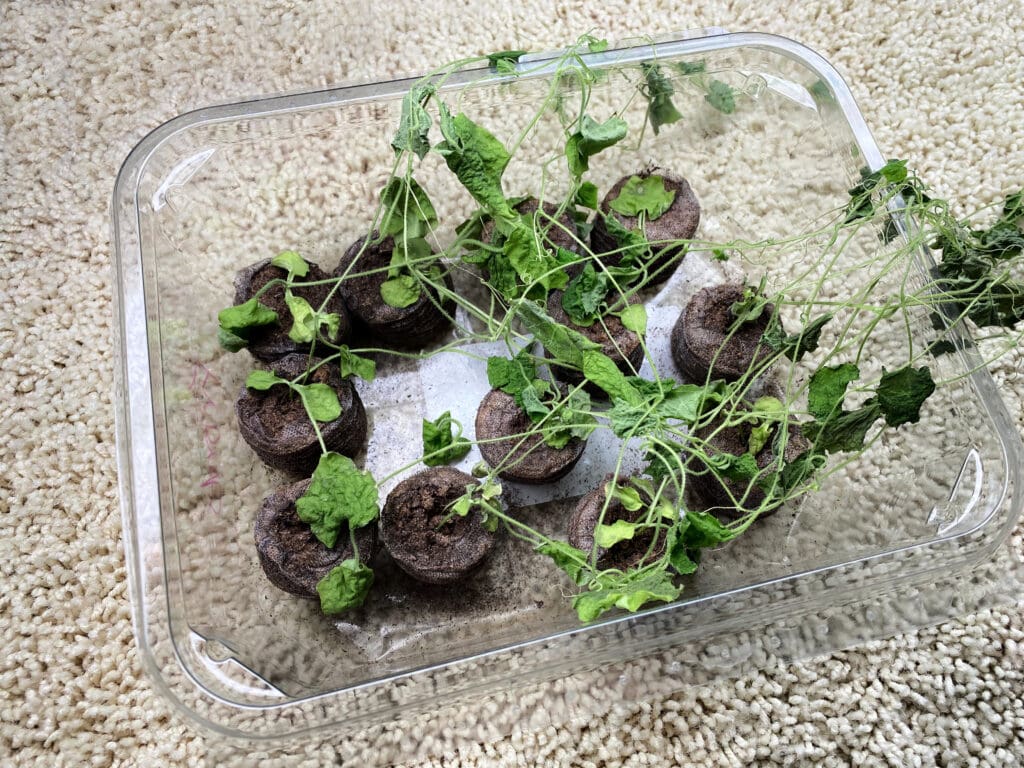
Tips For Preventing Seedling Problems
The best advice I can give you to help with your seedlings is to try to prevent these problems from happening in the first place. The good news is that there are only a few key things to remember:
- Sterilize all of your trays and other equipment every time you use it.
- Always use a good quality seedling potting soil.
- Keep the medium consistently moist, but never overly wet or saturated.
- Water your seedlings from the bottom rather than the top.
- Use grow lights and an outlet timer to give your seedlings the proper amount of light.
- Ensure adequate ventilation and airflow around your seedlings.
- Never overcrowd them, and pot them up once they outgrow the starter trays.
Read all about how to grow strong, healthy seedlings in my detailed care guide.
Don’t feel bad if you’ve experienced any (or all) of these seedling problems, we’ve all been there. Remember, many times prevention is the most important step you can take.
If you’re tired of struggling, and want to learn how to grow any plant you want from seed, then enroll in my online Seed Starting Course. It’s a wonderful, fun, self-paced course that will teach you everything you need to know to easily grow your own seedlings. Enroll and get started today!
Or, if you just need a refresher, then my Starting Seeds Indoors eBook is for you! It’s a quick-start guide that will get you planting seeds in no time.
More Seedling Care Posts
Share your tips for fixing seedling problems, or ask for more help in the comments section below.
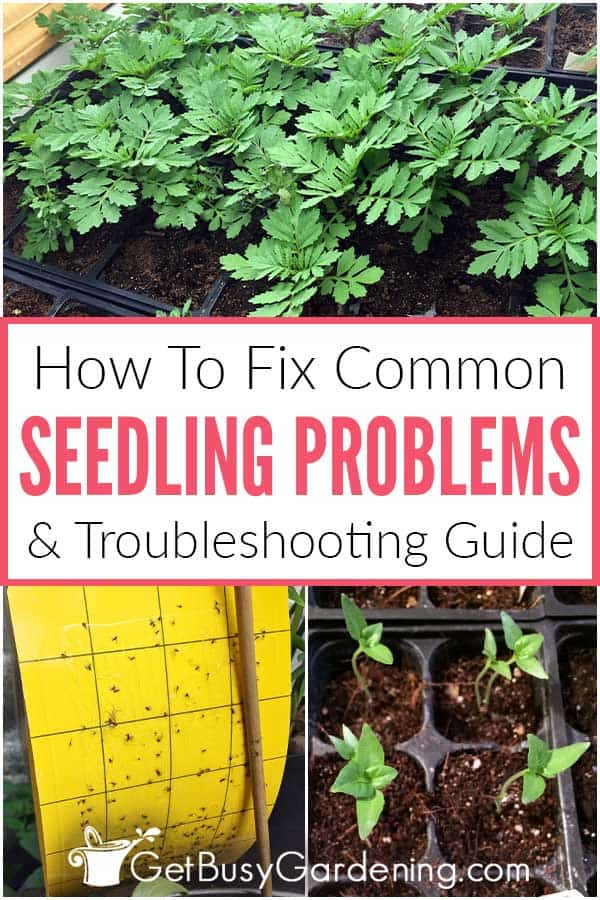
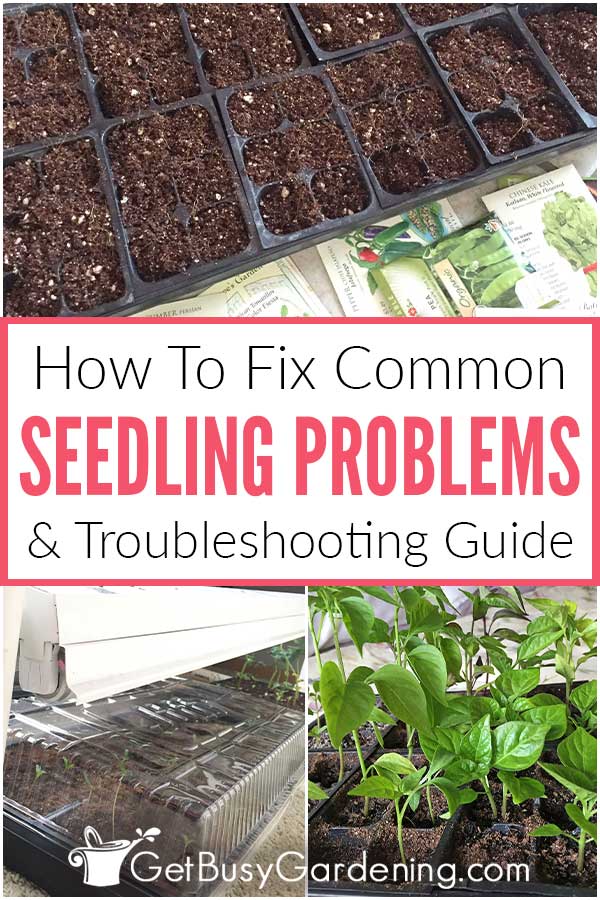
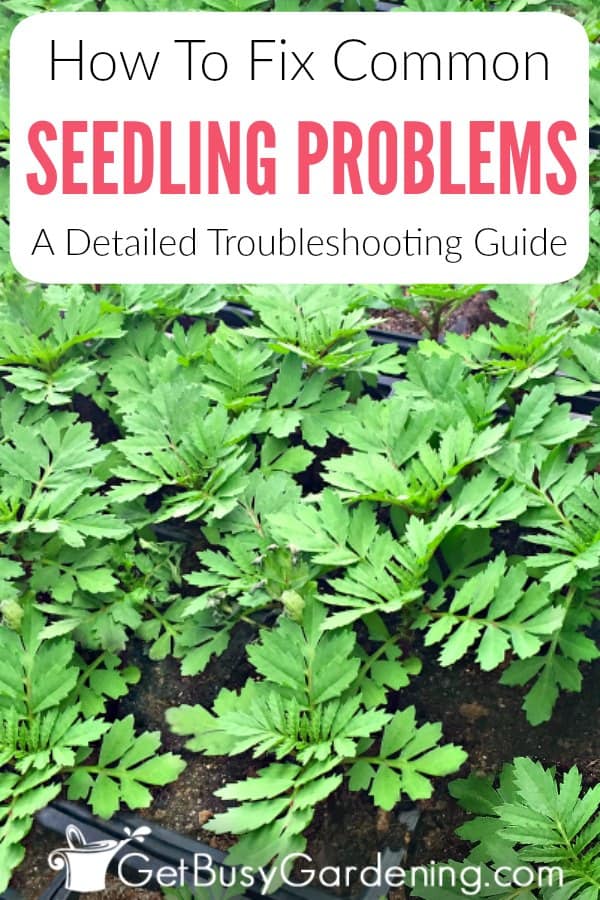
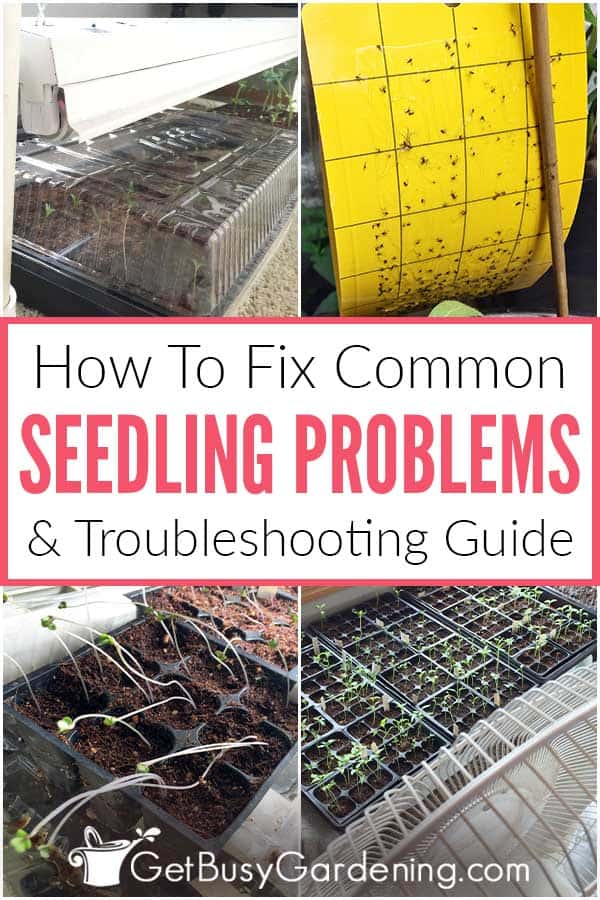

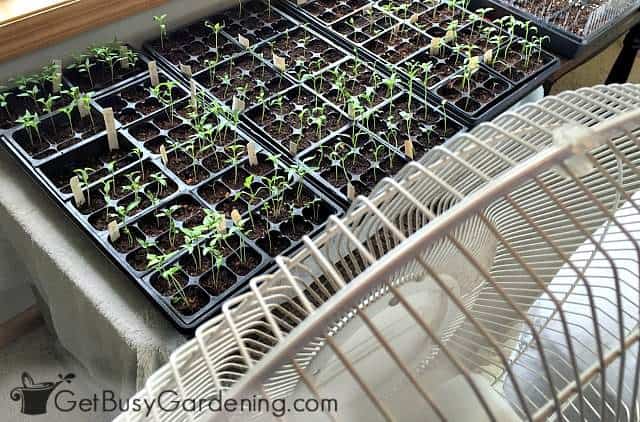
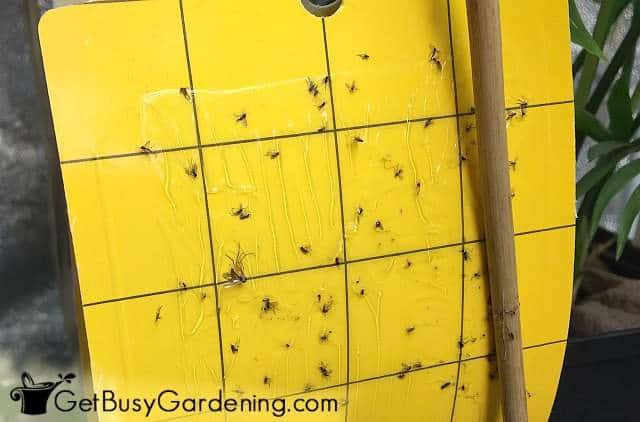
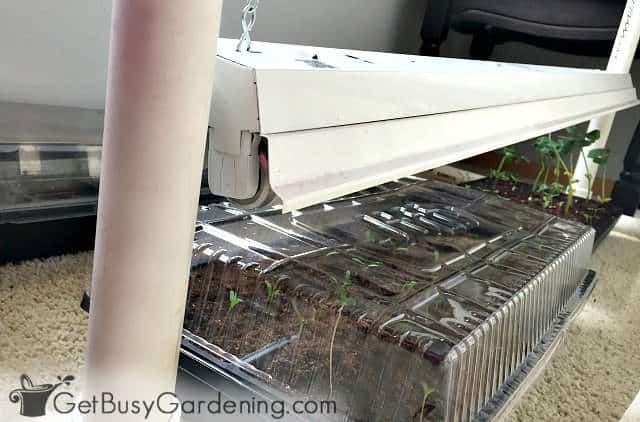


Judy says
I planted snapdragon seeds indoors with a cover and Heat mat. They sprouted beautifully and I took the cover off. A few days later the first leaves were gone but firm stems remained. They did not fall over with dampening off. The stems still remain. What the heck ate the first leaves?
Amy Andrychowicz says
It’s probably not that something ate them. The seedling leaves could have been destroyed by mold or dropped off due to overwatering, those are fairly common problems. Make sure the soil is moist but not wet or soggy, turn off the heat mats once the seeds germinate, and also vent the covers to give them some airflow.
Jessica says
Snapdragons don’t like heat mat and require less water than you think.
Amber Kuntz says
I can grow fantastic tomato plants from seed, but I am STRUGGLING big time with Broccoli. This is my 3rd time trying to grow them from seed and my poor seedlings grow and then once they start getting their first true leaf their original 2 leaves shrivel up and die. Why does this happen?
Amy Andrychowicz says
It’s normal for the first two leaves (called the “seed leaves”) to die after seedlings start getting their true leaves, so that’s nothing to be concerned about. They die faster on some types of seedlings than they do on others. Here’s my step-by-step guide for growing broccoli from seed that should help you.
Victoria says
I’m so glad I found your site! It’s my first attempt at starting flower seedlings inside with my 5 year old daughter and 3 year old son. Everyone was very excited when they all sprouted up nicely. Within about a week or two though I noticed some got so long and thin they flopped over. I found your site and quickly went out and got grow lights to remedy the issue. They looked a lot happier within a day or two and those that were still just emerging are looking straight and hardy…but, so many of them are still so long they don’t stand up and they are almost tangled within each other. Is there any hope for the them? Should I thin them? There’s about 3 long thin seedlings growing in each cell. Thanks!
Amy Andrychowicz says
Oh good, so glad to hear that the lights were the remedy your ailing seedlings needed, the new ones should do great. Yes, I would definitely recommend thinning out the scraggly looking seedlings, and keeping the thickest and strongest in each cell. Depending on the type of plant, sometimes they can recover as long as they have enough space and light. However, many times once seedlings get super stretched out and start flopping over, they won’t recover. So, it’s better to start over. I would keep some to see how they do, sometimes experimenting is the best teacher. 🙂 Good luck!
Sharon says
I started Morning Glory seeds on a window ledge and after ten days they are up three inches with no sign of true leaves….thinking of putting them outside for more sun here in Montreal…then maybe in at night?
Amy Andrychowicz says
Yes, it sounds to me like your seedlings are getting leggy. I would move your grow lights closer to them to help slow them down, and stop the legginess. If you do decide to put them outside, don’t put them into the full sun right away, or they will likely get sunburn and die. Be sure to harden them first, here’s how… How To Harden Off Seedlings
Jan says
I have tomato. seedlings under a 50 watt round grow light about 15 inches above tomato plants. 12 hours on. All bottom leaves keep slowly fallowing off they get large. The leaves that fall look healthy not curled or brown just fall off The top is still growing and producing new leaves but slowly. Never used a grow light before could it be too close. I over watered. Now trying to correct that. The plants look healthy and green just skeleton like with only top leaves. Please help. I put a fan on for a hour a day hoping that might help. Thank you. Jan ?
Amy Andrychowicz says
Overwatering is definitely what would cause the leaves to drop from your seedlings. You never want the soil to be soggy, so be sure to check it every time before you water again. The lights actually sounds like they could be a bit too far above the seedlings. I always recommend hanging them about an inch or so above the top of the seedlings. Otherwise they can start to grow tall and leggy. Good luck!
Gary Roger says
Your tips are very helpful. I’ve had some of these problems over the years but am experiencing a diff problem or at least it seems that way. I’ve been growing my own garden plants for over 30 yrs and have had a diff problem the last 2 years. My plants get off to a great start but after 2 or 3 weeks the lower leaves start drying up and start falling off. By the time I get ready to harden them off there isn’t much left to plant. After 2 or 3 weeks from planting the plants seem to slow down growing considerably and the leaves curl and dry up. Any suggestions?
Amy Andrychowicz says
Thank you, glad you found this article helpful! Sorry to hear about your seedling problems! There are two things that come to mind: the soil, or possibly a disease or fungus issue (I suspect it’s a problem with the soil). First, I would test the soil you are using to make sure it’s not too acidic, and that it has plenty of nitrogen. A nice light, airy alkaline soil that is rich in nitrogen is the best for healthy seedlings (here’s how to test the soil with a home kit). Second, is there any sign of disease or fungus on the leaves before they die and fall off? Perhaps some black or brown spots, or the leaves look faded or sickly? To prevent fungus and disease, always be sure to throughly clean and disinfect the seed trays before starting. Good luck! I hope you figure out the issue, and get it fixed so you have strong, healthy seedlings this year!